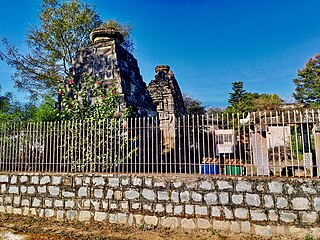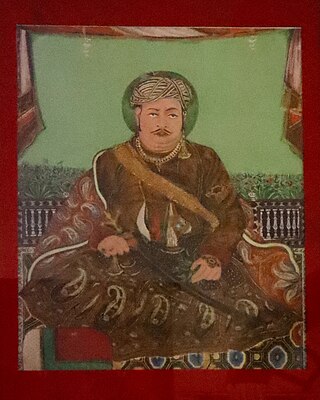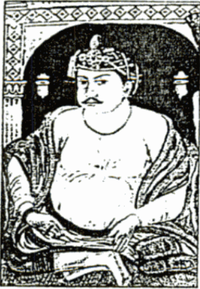
Gondwana, also known as Gondaranya, the land of Gondwana, is a region of India named after the Gondi people. The supercontinent, Gondwanaland, was named after the Gondwana region, because it contained some ancient fossil-bearing rock formations.

The Gondi (Gōṇḍī) or Gond people, who refer to themselves as "Kōītōr", are an ethnolinguistic group in India. Their native language, Gondi, belongs to the Dravidian family. They are spread over the states of Madhya Pradesh, Maharashtra, Chhattisgarh, Uttar Pradesh, Telangana, Andhra Pradesh, Bihar, and Odisha. They are listed as a Scheduled Tribe for the purpose of India's system of reservation.

Bhandara District is an administrative district in the state of Maharashtra in India. The name Bhandara is a corruption of Bhanara. Reference to Bhanara is found in an inscription of 1100 A.D. traced at Ratanpur. The district headquarters are located at Bhandara. The district occupies an area of 3717 km2 and has a population of 1,200,334, of which 19.48% are urban as of 2011. The growth rate of Bhandara is 5.56% Bhandara has a mixed economy with agriculture, industries and forest resources. Bhandara is known for its large production of rice. Tumsar, a tahsil town, is a noted rice market. Bhandara town is also known as "Brass City" owing to the presence of a large brass products industry. Bhandara has several tourist destinations, like Ambagad Fort, Brahmi, Chinchgad, and Dighori.

The Wainganga is a river in India originating in the Mahadeo Hills in Mundara in Gondwana region near the village Gopalganj in Seoni, Madhya Pradesh. It is a key tributary of the Godavari. The river flows south in a winding course through the states of Madhya Pradesh and Maharashtra, roughly 580 km (360 mi). After joining the Wardha River, the united stream, which is known as the Pranahita River, empties into the Godavari River at Kaleshwaram, Telangana.

Jabalpur Division is an administrative geographical unit of Madhya Pradesh state of India. Jabalpur is the administrative headquarters of the division. As of 2023, the division consists of districts of Balaghat, Chhindwara, Jabalpur, Katni, Mandla, Narsinghpur, Dindori, Seoni and Pandhurna.

Balaghat district is a district of Madhya Pradesh state in Central India. Its belongs to Jabalpur Division. Balaghat city is Administrative Headquarter of Balaghat District.

Chhindwara district is one of the major districts of Madhya Pradesh state of India, and Chhindwara town is the district headquarters. Chhindwara was the largest district in Madhya Pradesh with an area of 10,293 square km before the bifurcation of Pandhurna district. The district is part of Jabalpur division.

Seoni District is a district of Madhya Pradesh state in central India. The town of Seoni is the district's headquarters.

The Kingdom of Nagpur was a kingdom within the Maratha Confederacy in the 18th and 19th centuries. It was ruled by the Maratha Bhonsle dynasty in the mid-18th century. The city of Nagpur was the capital of the state.

The history of Nagpur, in central India, spans over 5,000 years, including the Kingdom of Nagpur in the 18th and 19th century. Human existence around present-day Nagpur city can be traced back 3,000 years to the 8th century BC. Menhir burial sites at Drugdhamna indicate megalithic culture existed around Nagpur and is still followed in present times.
The Rajgonds are the ruling class of the Gonds. The region of Gondwana consisted of neighbouring kingdoms. To the south was the Kingdom of Chanda and to the north was the powerful Garha-Mandla kingdom. In the 16th century, the Kingdom of Deogarh rose as a powerful state with the Kherla Kingdom in its western past.
Ajanbahu Jatbasha is considered by historians to be founder of the Gond dynasty of Chhindwara and Nagpur, which ruled the present days territories of Madhya Pradesh, Chhattisgarh and part of Maharashtra in the 16th-18th centuries. Documentation of his origins and rise to power have not survived, but he is the first historical leader of the mountain Gondi people.

Chand Sultan (1706-1739) was a Gond king of Nagpur. He was the eldest son and successor of Bakht Buland Shah of Deogarh. He ascended the throne of Deogarh in 1706 and shifted his capital from Deogarh to Nagpur. He carried out further reforms in his kingdom and planned layout of the new city of Nagpur and under him, the kingdom prospered. He was a kind ruler who loved his people and extended his territory considerably to the east of the river Wainganga.
The Gondwana Kingdoms were the ruling kingdoms in the Gondwana region of India. The Gondwana region includes the core region of the eastern part of the Vidarbha of Maharashtra, Garha Kingdom, the parts of Madhya Pradesh immediately to the north of it, and parts of western Chhattisgarh. The wider region extends beyond these, also including parts of northern Telangana, western Odisha and southern Uttar Pradesh.

The Garha kingdom, also called Garha-Mandla or Garha Katanga, was an early-modern-era kingdom in India. It was the first large kingdom to be founded by the Gond tribe kings and was based in Central India. The kingdom was founded in the 15th century and lasted until conquest by the Maratha Confederacy in 1781.

The Bhonsles of Nagpur were a Maratha royal house that ruled the Kingdom of Nagpur from 1739-1853. They hailed from the Bhonsle clan of Marathas and were one of the most important and powerful Maratha chiefs in the Maratha Confederacy.

The Gonds of Deogarh were a Gond royal house that ruled large parts of the Vidarbha region and parts of present-day southern Madhya Pradesh. Their Kingdom consisted of the area which later became the Nagpur Kingdom. They made Nagpur region a prosperous and plentiful kingdom, founding the city of Nagpur and building further infrastructure. However, internal bickering led to their decline and they were practically made state pensioneries by the Maratha general Raghoji I Bhonsle in the 1743.
The siege of Nagpur was laid by Khan-i-Dauran, a high-ranking Mughal official to the fort of Nagpur, ruled by the Gond king of Deogarh, Kok Shah.
The Kingdom of Chanda was one of the main Gond kingdoms, ruling parts of central India. In 1751, it was conquered by the Maratha ruler of Nagpur, Raghoji I Bhonsle.

Chhapara or Seoni Chhapara is a town and a Nagar Panchayat in Seoni District of Madhya Pradesh, India.
















